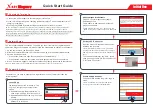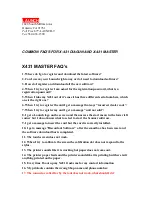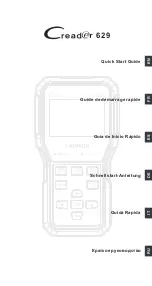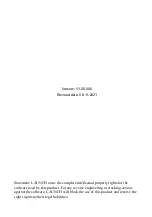
APPENDIX
IMPORTANT CONSIDERATIONS FOR RISE TIME
AND FALL TIME MEASUREMENTS
Error in Observed Measurement
The observed rise time (or fall time) as seen on the CRT
is actually the cascaded rise time of the pulse being meas-
ured and the oscilloscope’s own risetime. The two rise times
are combined in square law addition as follows:
T
observed
=
The effect of the oscilloscope’s rise time is almost negli-
gible when its rise time is at least 3 times as fast as that of
the pulse being measured. Thus, slower rise times may be
measured directly from the CRT. However, for faster rise
time pulses, an error is introduced that increases progres-
sively as the pulse rise time approaches that of the oscillo-
scope. Accurate measurements can still be obtained by
calculation as described below.
Direct Measurements
The Model 2190B oscilloscope has a rated rise time of
3.5 ns. Thus, pulse rise times of about 11 ns or greater can
be measured directly. Most fast rise times are measured at
the fastest sweep speed and using X10 magnification. For
the Model 2190B, this sweep rate is 2 ns/div. A rise time of
less than about five divisions at this sweep speed should be
calculated.
Calculated Measurements
For observed rise times of less than 11 ns, the pulse rise
time should be caluclated to eliminate the error introduced
by the cascaded oscilloscope rise time. Calculate pulse rise
time as follows:
T
pulse
=
Limits of Measurement
Measurements of pulse rise times that are faster than the
scope’s rated rise time are not recommended because a very
small reading error introduces significant error into the
calculation. This limit is reached when the “observed” rise
time is about 1.3 times greater than the scope’s rated rise
time, about 4.5 ns minimum for the Model 2190B.
Probe Considerations
For fast rise time measurements which approach the limits
of measurement, direct connection via 50
Ω
coaxial cable
and 50
Ω
termination is recommended where possible.
When a probe is used, its rise time is also cascaded in square
law addition. Thus the probe rating should be considerably
faster than the oscilloscope if it is to be disregarded in the
measurement.
(T
) + (T
)
pulse
2
scope
2
(T
) + (T
)
observed
2
scope
2
19




































